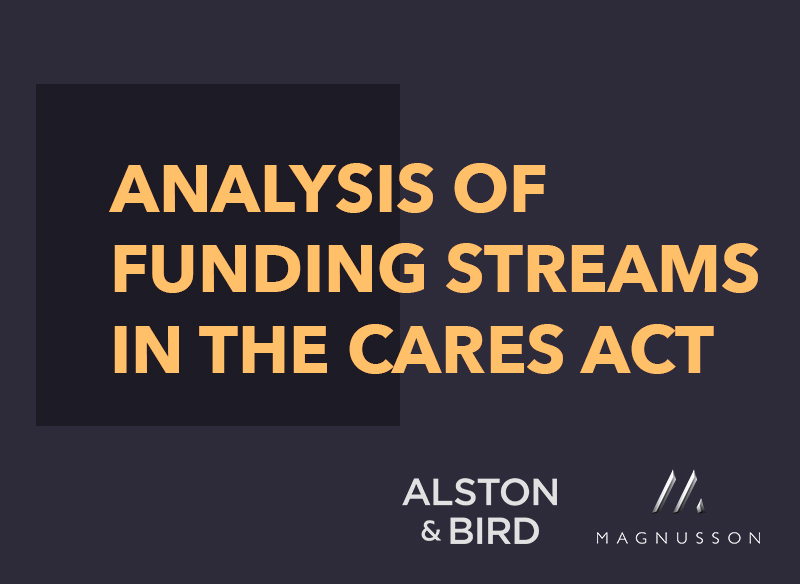
During these uncertain times we believe at Magnusson that knowledge sharing is an essential component for everyone and in every company. We are pleased to start sharing news related to Covid-19 from jurisdictions outside Magnusson’s home region of the Nordics and Baltics, for the benefit of our clients and contacts with businesses operations abroad. The first news is about the funding streams under the CARES Act in the US in response to the Covid-19 outbreak.
Disclaimer: Magnusson is not responsible for the content. For further information, please contact Soren Lindstrøm.
Funding Stream 1: $367 Billion for Small Business Administration
Who oversees small business loans?
- The Small Business Administration (SBA) is the primary federal agency that supports small businesses and entrepreneurs.
What types of loans are currently available through the SBA?
- The SBA works with lenders to provide loans to small businesses. The agency does not lend money directly to small business owners. Instead, it sets guidelines for loans made by its partnering lenders, community development organizations, and micro-lending institutions.
- There are three common financial assistance programs overseen by SBA – the “7(a) loan program”, the “7(b) loan program” and the Small Business Investment Company (SBIC) financial assistance program.
- The 7(a) loan program is SBA’s primary program for providing financial assistance – in the form of loans – to small businesses. In order for a small business to be eligible, the business must, in addition to other requirements:
- Be registered as a for-profit business;
- Not employ more than a certain number of employees or exceed stated revenue thresholds; and
- Be physically based in the US.
- Section 7(b) of the Small Business Act includes the Economic Injury Disaster Loan (EIDL) program, which distributes loans in amounts up to $2 million for certain small businesses and non-profits facing economic injury as a result of declared emergencies like the coronavirus (COVID-19).
- The SBIC program allows licensed privately-operated investment funds to provide financing to eligible small businesses in the form of loans, debt securities, equity securities, guarantees or purchase of securities in a small business.
What is new for small businesses under the latest stimulus bill?
- The Coronavirus Aid, Relief, and Economic Security (CARES) Act creates a new 7(a) loan program, known as the Paycheck Protection Loan. Congress initially is appropriating $349 billion of funding for this new program.
- The legislation also modifies and increases funding for the existing EIDL program under Section 7(b).
- The legislation relaxes participation requirements, meaning more business will be deemed “small” and eligible for economic assistance.
- The legislation provides funding for deferments of loans in place.
- The legislation establishes a program to provide training and resources to small businesses affected by coronavirus.
What is the Paycheck Protection Loan?
- The Paycheck Protection Loan is a new program under Section 7(a) of the Small Business Act.
- The loan provides to recipients up to the lesser of (i) 2.5x the average total monthly payroll costs during the year preceding application and any amounts loaned to the recipient under the EIDL program this year, or (ii) $10 million.
- “Payroll costs” include salaries, wages, commissions, cash tips, payment for vacation, parental or sick leave, allowance for dismissal or separation, payment of group healthcare benefits, payment of retirement benefits, and payment of state and local tax assessed on compensation.
- “Payroll costs” exclude compensation in excess of an annual salary of $100,000 (prorated for the covered period), taxes imposed or withheld under Chapters 21, 22 or 24 of the Internal Revenue Code, compensation for non-U.S. domiciled employees, and family or sick leave wages for which a credit has been received under the Families First Coronavirus Response Act.
- Paycheck Protection Loans will have complete payment deferral (including principal, interest and fees) for at least 6 months, and up to a maximum of 1 year.
- Paycheck Protection Loans will have a term of no longer than 10 years after the date a borrower has applied for loan forgiveness and a maximum interest rate of 4%.
- Applicants can receive loan forgiveness equal to their payroll (subject to the limitations on “payroll costs” set forth above), rent, mortgage interest and utility costs incurred and payments made during the 8-week period following the origination of the loan if they maintain the same number of FTEs during such 8-week period as compared to the FTE count during a statutorily defined reference period in the past; the loan forgiveness is scaled down proportionally with any decrease in FTEs during such covered period or if any FTE salaries are decreased by more than 25%.
Do I qualify for the Paycheck Protection Loan?
- Congress has relaxed the eligibility criteria for the 7(a) loan program.
- In addition to traditional small businesses under SBA rules, eligible entities include any business (including nonprofits, veterans organizations and Tribal businesses) that employs fewer than 500 employees (unless the applicant’s primary industry is subject to a higher employee-based size standard, in which case the applicant must be “small” under that higher standard). Certain self-employed workers and independent contractors are eligible, too.
- Example: Applicant A’s primary industry is subject to a 250-employee size standard but actually employs 350 employees. Applicant B’s primary industry is subject to a 1,000-employee size standard but actually employs only 750 employees. Both applicants would qualify under the CARES Act paycheck protection assistance:
- Applicant A qualifies because, even though it otherwise would not be “small” under its NAICS code for traditional SBA financial assistance, it is “small” for purposes of the CARES Act because it employs fewer than 500 employees.
- Applicant B qualifies because, even though it employs more than the 500-employee limit established in the CARES Act, it operates in an industry with a higher employee-based size standard and it qualifies as “small” under that standard.
- Congress has also provided that businesses in the hospitality, food and beverage industry with more than one business location qualify provided that no single location has more than 500 employees.
- Example: Applicant A’s primary industry is subject to a 250-employee size standard but actually employs 350 employees. Applicant B’s primary industry is subject to a 1,000-employee size standard but actually employs only 750 employees. Both applicants would qualify under the CARES Act paycheck protection assistance:
Funding Stream 2: Treasury’s Business Stabilization Loan Fund
This $500 billon fund will allow the Secretary of the Treasury to provide loans and loan guarantees to support credit facilities that will be established by the Federal Reserve.
Who is eligible for the Treasury program?
- Businesses that have not otherwise received adequate economic relief in the form of loans or loan guarantees provided under this Act are eligible.
How is this fund allocated?
- Congress authorized $46 billion to be directed to the following industries: passenger air carriers and some related industries; cargo air carriers; businesses important to maintaining national security.
- The remaining $454 billion, as well as any amounts available but not used for direct lending, are available for loans, loan guarantees, and investments in support of the Federal Reserve’s lending facilities to businesses, states, and municipalities.
Who is eligible for a direct lending loan?
Entities applying for a direct lending loan must meet the following criteria:
- Alternative financing is not reasonably available to the business;
- The loan is sufficiently secured or made at an interest rate that reflects the risk of the loan and, if possible, not less than an interest rate based on market conditions for comparable obligations before the coronavirus outbreak;
- The duration of the loan shall be as short as possible and shall not exceed 5 years;
- Borrowers and their affiliates must agree not to engage in stock buybacks, unless previously contractually obligated, or pay dividends until one year after the date of repayment of the loan;
- Borrowers must commit to maintain their employment levels as of March 24, 2020 until September 30, 2020, to the extent practicable, and in any event to retain no less than 90 percent of their employees as of March 24, 2020;
- A borrower must certify that it is a U.S.-domiciled business and its employees are predominantly located in the U.S.;
- The loan cannot be forgiven; and
- In the case of borrowers critical to national security, their operations are jeopardized by losses related to the coronavirus pandemic.
Who is eligible for the Federal Reserve’s lending facilities?
There is no restriction on the ability of any business to apply for support through the Federal Reserve’s lending facilities, which facilities will have access to the residual $454 billion plus any amounts not lent directly by Treasury. Businesses may only apply for these funds if they agree to the following criteria:
- agreement not to pay dividends or engage in buybacks of the borrower entity’s own equity or the equity of any parent company, in either case until one year after the loans have been repaid; and
- agreement to comply with the executive compensation limitations applicable to individuals making more than $425,000 and to individuals making more than $3 million per year, which limitations are described below.
The Secretary may waive these requirements, but is required to make himself available to testify before the Senate Banking and House Financial Services Committee regarding the reasons for any such waiver.
What if I am a non-profit or a business that employs between 500-10,000 employees?
- The Secretary will endeavor to implement a special credit facility through the Federal Reserve targeted specifically at non-profit organizations and businesses between 500 and 10,000 employees, subject to additional loan criteria and obligations, including:
- The funds received must be used to retain at least 90 percent of the recipient’s workforce, with full compensation and benefits, through September 30, 2020;
- The recipient will not outsource or offshore jobs for the term of the loan plus an additional two years;
- The recipient will not abrogate existing collective bargaining agreements for the term of the loan plus an additional two years; and
- The recipient must remain neutral in any union organizing effort for the term of the loan.
- Note: The Secretary is authorized to create this facility without restriction to the Federal Reserve’s existing authority to create a Main Street Lending Program. This Program would not be required to have all of the above restrictions and may ultimately be the principal way that the CARES Act resources are channeled to provide relief to medium-sized businesses.
If I accept this loan, what executive compensation obligations will apply?
- The Secretary may enter into an agreement with an eligible business only if, between March 1, 2020 and March 1, 2022, no employee or officer making greater than $425,000 in 2019:
- Receives a raise in compensation; or
- Receives severance pay or benefits exceeding twice the maximum total compensation received by the employee in 2019.
- Additionally, employees of a borrower whose compensation exceeds $3 million per year will be required to reduce their compensation.
Where do I get more information?
- Treasury is expected to issue additional guidance imminently.
Funding Stream 3: Tax Credits and Other Potentially Beneficial Tax Considerations
The CARES Act includes a number of potentially beneficial tax provisions for businesses, some of which apply generally across industries, while others are targeted to benefit specific industries (e.g., hospitality).
Section 2301 – Employee retention credit for employers subject to closure due to COVID-19.
- Provides a refundable payroll tax credit to qualifying employers on a dollar-for-dollar basis equal to 50% of qualifying wages paid by such employers to employees during the COVID-19 crisis, resulting in a maximum potential net credit of $5,000 per employee.
- The credit is available to employers whose (i) operations were fully or partially suspended due to a COVID-19-related government shutdown order (and only during periods in which its operations are fully or partially suspended), or (ii) gross receipts for a given quarter beginning after December 31, 2019 declined by more than 50 percent when compared to the same quarter in the prior year.
- The credit is based on qualified wages paid to the employee. Qualified wages include an allocable share of health benefits paid by an employer on behalf of the employee.
- Any family or sick leave wages for which a credit has been received under the Families First Coronavirus Response Act do not count as qualified wages for purposes of this credit.
- For employers who had an average of more than 100 FTEs during 2019, qualified wages are wages paid to employees when those employees are not providing services to the employer due to the COVID-19-related circumstances described above (i.e. (i) and (ii) in the second bullet).
- For eligible employers who had an average of 100 or fewer FTEs during 2019, all employee wages qualify for the credit, whether the employer is open for business or subject to a shut-down order.
- The credit is provided for wages paid or incurred from March 13, 2020 through December 31, 2020.
Section 2302 – Delay of payment of employer payroll taxes.
- Allows employers and self-employed individuals to defer payment of the employer share of the Social Security tax they otherwise are responsible for paying to the federal government with respect to their employees.
- As a general matter, employers are responsible for paying a 6.2-percent Social Security tax on employee wages.
- Section 2302 provides that employers can defer the tax due from the date of enactment of the Act through December 31, 2020.
- The provision requires that the deferred employment tax be paid over the following two years, with half of the amount required to be paid by December 31, 2021 and the other half by December 31, 2022.
Section 2307 – Technical amendment regarding qualified improvement property.
- Enables businesses to take an immediate deduction for costs associated with improving facilities instead of having to depreciate those improvements over the 39-year life of the building.
- The provision, which corrects an error in the Tax Cuts and Jobs Act, not only increases companies’ access to cash flow by allowing them to amend a prior year return, but also incentivizes them to continue to invest in improvements as the country recovers from the COVID-19 emergency.










